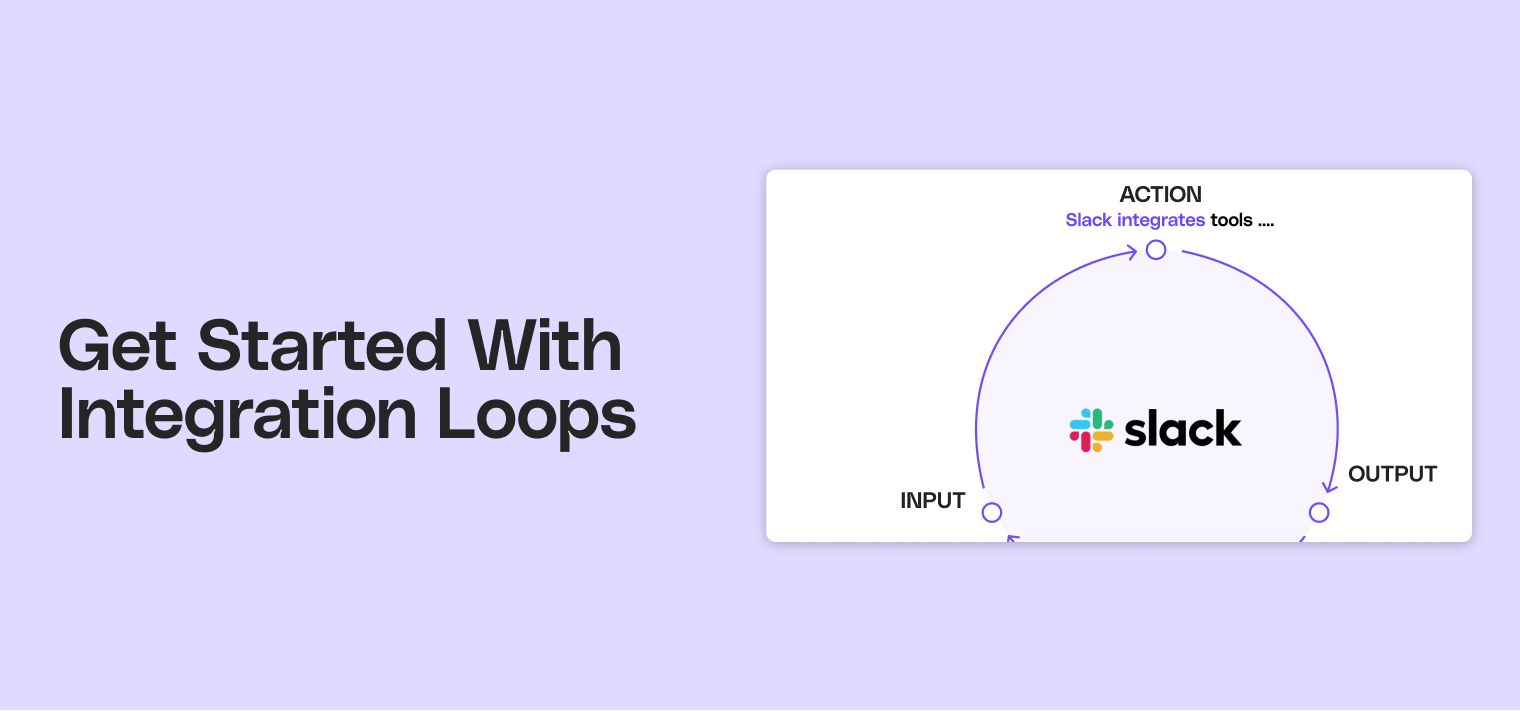- Understanding the basics of integration loops
- Types of integration loops
- Designing an integration loop
- Implementing integration loops
- Best practices
- Troubleshooting integration loops
- Optimizing integration loops
- Future trends
- Prediction and preparation for the future
- Conclusion
- Empower Your Integration with Cello
- Understanding the basics of integration loops
- Types of integration loops
- Implementing integration loops
- Troubleshooting integration loops
- Optimizing integration loops
- Future trends
- Empower Your Integration with Cello
You will gain a complete understanding of integration loops and how they benefit your organization's operations and growth.
| Key Element | Description | Optimization Tips |
|---|---|---|
| Integration Loops | Cycles where companies reinvest capital into integrations or partnerships, increasing value for users and attracting new ones. | Define clear objectives, assess system compatibility, choose appropriate integration approach, design robust architecture, implement and test thoroughly, monitor and optimize continuously |
| Key Components | Essential elements for smooth integration and value generation, including product compatibility, user-centric design, strategic partnerships, continuous feedback loop, and robust support system. | Ensure product flexibility and adaptability, create intuitive user interfaces, form strategic alliances with complementary services, actively seek and incorporate user feedback, provide dedicated customer support and resources |
| Types of Integration Loops | Categories include vertical, horizontal, ecosystem, customer-centric, and operational integration loops. | Identify the most suitable type for your business needs, consider combining multiple types for comprehensive integration, align chosen types with overall business strategy |
| Implementation Tools | Software and platforms facilitating integration loop implementation, such as Zapier, MuleSoft AnyPoint Platform, Apache Camel, and Microsoft Power Automate. | Select tools based on specific integration requirements, consider scalability and ease of use when choosing tools, evaluate cost-effectiveness and long-term support |
| Best Practices | Start with small pilot projects, implement robust security measures, continuously monitor performance, maintain clear documentation, design for scalability. | Optimize data processing, minimize latency and strategize error handling. |
| Future Trends | Emerging technologies and approaches shaping the future of integration loops, including AI/ML, IoT integration, blockchain, serverless computing, and 5G/edge computing. | Stay informed about technological advancements, prepare for increased automation and real-time processing, focus on security, compliance, and data governance, embrace open standards and flexible architectures |
Understanding the basics of integration loops
Integration loops are a fundamental concept in system integration, enabling seamless data exchange between various systems. They significantly improve product development by allowing rapid iteration and feedback incorporation, leading to higher-quality products. Definition and importance of integration loops
⚙️🔁 An integration loop occurs when a company generates capital and reinvests this into integrations or partnerships, increasing the primary value promise of its users and attracting new ones.
Similarly, platforms like Stripe and Chargebee, the payment processing solutions, achieve the growth with their own extensive app marketplaces. These marketplaces integrate with various tools for invoicing, subscription management, and analytics. They enhance efficiency, scalability, and support customization for diverse business needs.
Key components
Key components that work together to enable smooth integration and generate value for users in terms of user experience, product, and partnership-wise include:
- Product Compatibility: Ensuring the core product is flexible and adaptable to integrate with other popular tools and platforms, making it easy for users to connect their existing systems and enhancing overall product experience.
- User-Centric Design: Creating an intuitive interface that simplifies the integration process, reducing the need for technical expertise and making it accessible to a broader audience, thereby improving user experience.
- Strategic Partnerships: Forming alliances with other leading software providers to offer complementary services. These partnerships enhance the value proposition by providing users with a comprehensive suite of interconnected tools, enriching both user and product experience.
- Continuous Feedback Loop: Actively seeking and incorporating user feedback to improve and expand integration capabilities. This helps address user needs and keeps the product relevant and effective, enhancing overall user satisfaction.
- Robust Support System: Offering dedicated customer support and resources to assist users in setting up and managing integrations, ensuring a smooth and efficient experience, and fostering strong partnerships with users.
These components work together to create a seamless integration environment, enhancing user satisfaction and driving the company's growth through continuous reinvestment in partnerships and technology.

By understanding these key components, you can appreciate the complexity and importance of integration loops in today's interconnected business landscape.
Use case: Slack
Slack's strategic integration approach not only enhances user productivity and workflow efficiency but also fosters seamless collaboration by seamlessly connecting with essential tools and platforms, thereby maximizing business productivity and user satisfaction. Here's how Slack achieves this:
- Product Compatibility: Ensuring seamless integration with a wide array of productivity tools such as Google Drive, Zoom, and Salesforce.
- User-Centric Design: Simplifying the process of connecting and managing integrations with an intuitive interface.
- Strategic Partnerships: Forging alliances with major software providers like Atlassian and Microsoft to expand functionality.
- Continuous Feedback Loop: Actively incorporating user feedback to refine and enhance integration features.
- Robust Support System: Providing dedicated customer support and resources for seamless integration management.
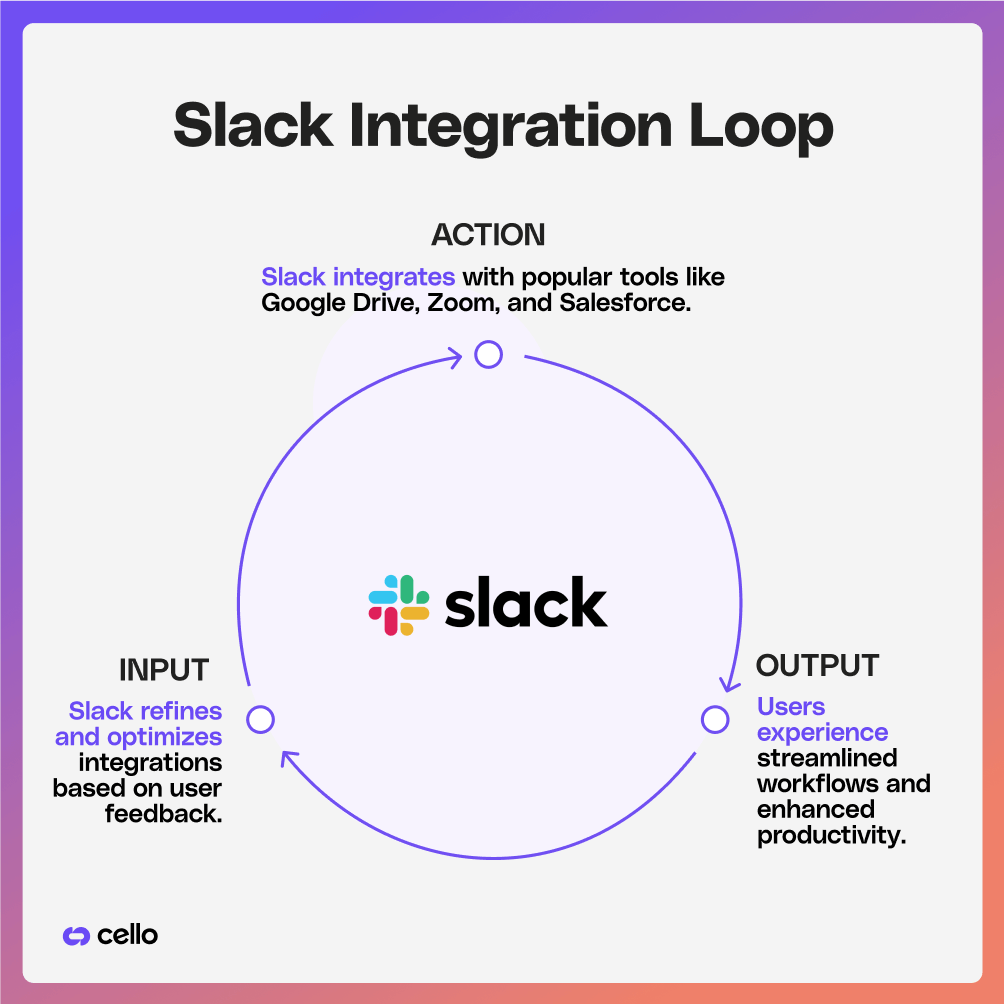
Types of integration loops
Types of integration loops can be categorized as vertical, horizontal, ecosystem, customer centric and operational as following:
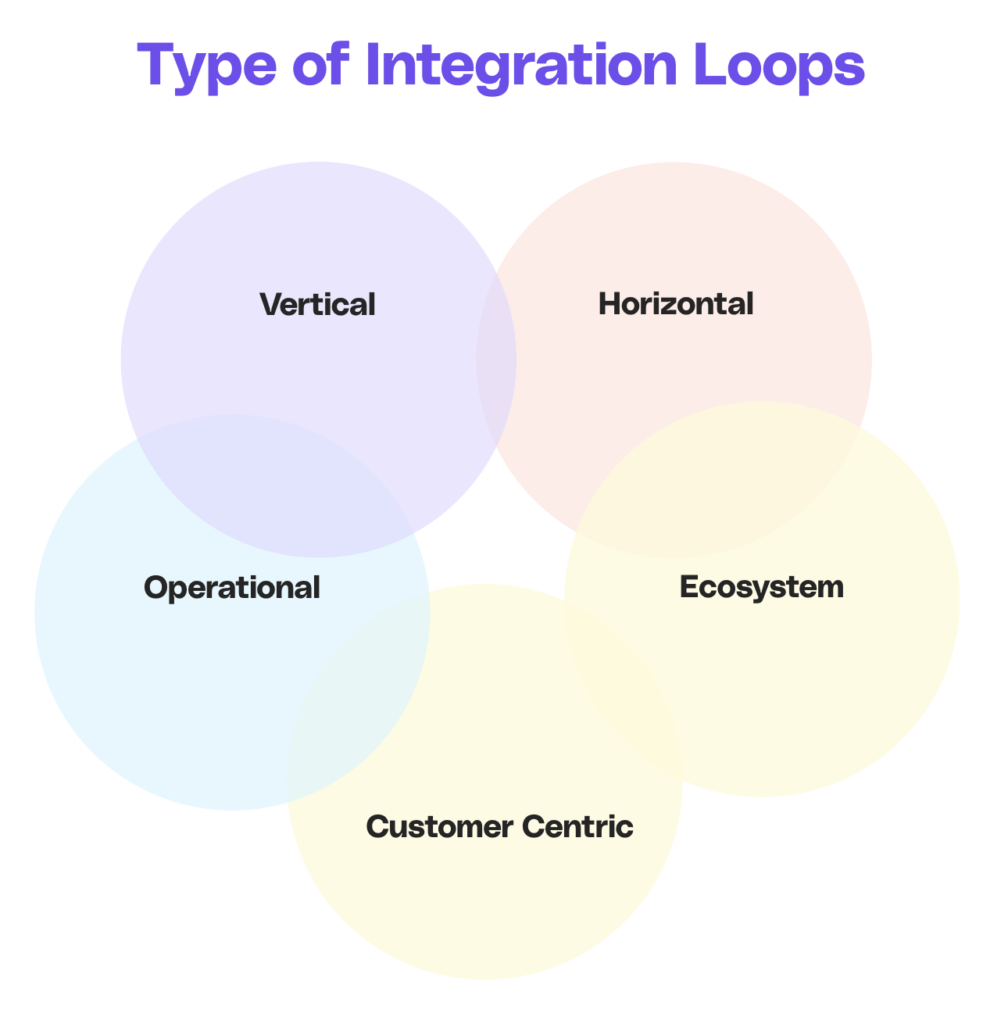
Vertical Integration Loops: Involve integrating different stages of a single industry's supply chain. For example, Apple vertically integrates by designing hardware (like iPhones and MacBooks) and developing operating systems (iOS and macOS), creating a seamless user experience with services like iCloud and Apple Music.
Horizontal Integration Loops: Integrate complementary services across different industries. Facebook, for instance, integrates social media (Facebook), messaging (Messenger and WhatsApp), virtual reality (Oculus VR), and digital advertising (Facebook Ads), connecting billions of users globally in a comprehensive digital ecosystem.
Ecosystem Integration Loops: Ecosystem loops focus on creating a network of interconnected products and services that enhance the value of each component. Examples include platforms like Amazon Web Services (AWS), where various cloud computing services are integrated to provide a robust and scalable solution for businesses.
Customer-Centric Integration Loops: Prioritize tools improving customer experience. Zendesk integrates customer service platforms, live chat, call center software, and customer feedback tools to engage customers across channels and enhance satisfaction.
Operational Integration Loops: Involve integrating various internal business processes to improve efficiency and decision-making. Workday uses cloud-based software for financial management, human capital management, payroll, and analytics to streamline HR and finance operations effectively.
Designing an integration loop
Designing an integration loop requires a thorough understanding of systems, data, and desired outcomes. Below is the steps to design an effective loop:
- Define Objectives: Clearly outline integration goals and identify specific problems or inefficiencies to address.
- Assess Compatibility: Evaluate system compatibility, including APIs, data formats, and security requirements.
- Choose Integration Approach: Select the appropriate method (e.g., point-to-point, middleware-based) based on complexity and scalability needs.
- Design Architecture: Create a detailed plan for how systems will communicate, including data mappings and synchronization processes.
- Implement and Test: Execute the integration plan, develop connectors, and conduct thorough testing to ensure functionality and data accuracy.
- Monitor and Optimize: Continuously monitor system performance, gather user feedback, and iterate on the integration to improve efficiency and effectiveness.
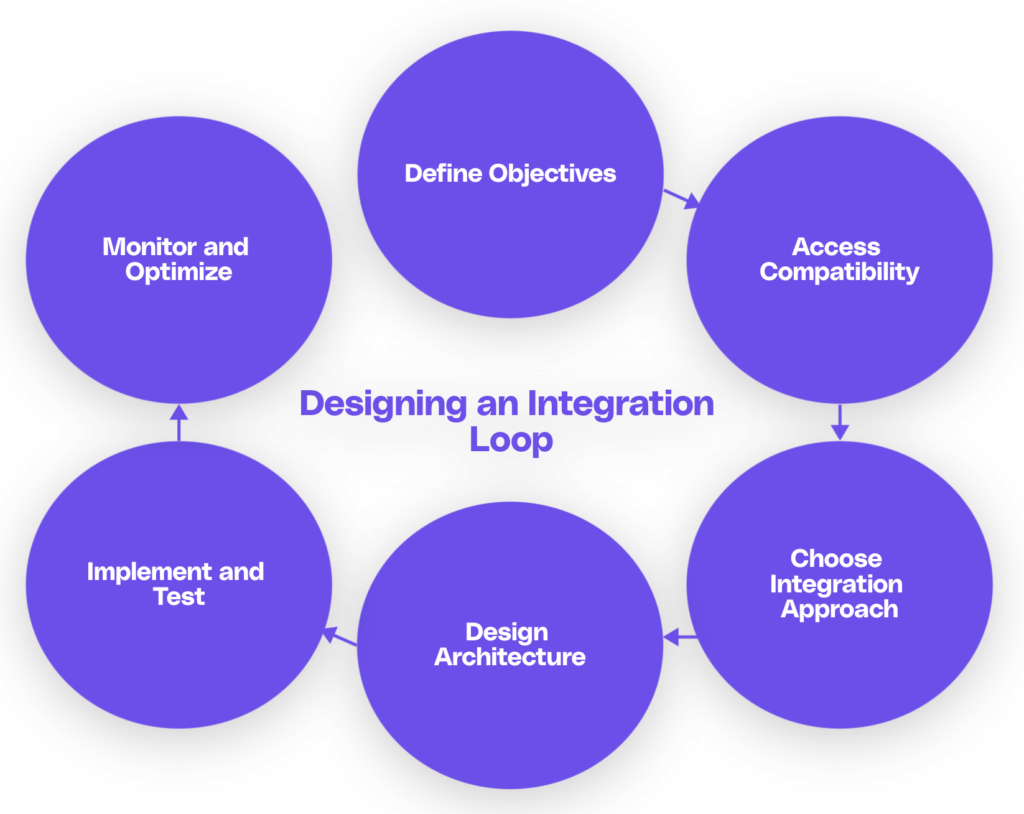
Let's explore how Apple designs and executes its integration strategy step-by-step.
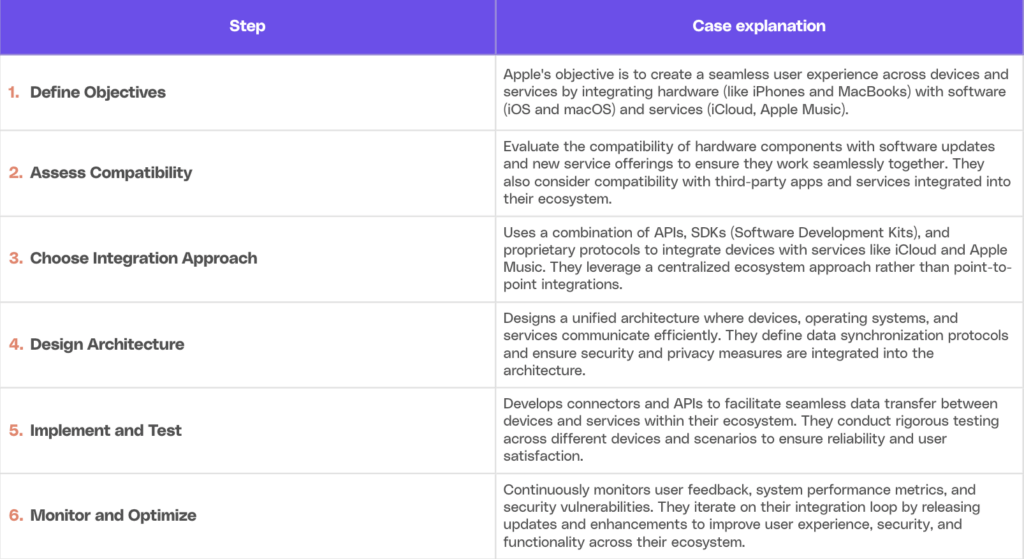
Through these steps, Apple maintains a cohesive integration loop that enhances user experience, fosters loyalty, and drives innovation within their ecosystem of products and services.
Common mistakes to avoid in designing integration loops
- Overlooking Clear Objectives: Failing to define specific integration goals and objectives can lead to ambiguous outcomes and misaligned efforts.
- Neglecting Compatibility Assessment: Not thoroughly evaluating system compatibility, including APIs, data formats, and security requirements, can result in integration failures or data inconsistencies.
- Choosing Incorrect Integration Approach: Selecting the wrong integration method (e.g., point-to-point vs. middleware-based) without considering scalability, complexity, and long-term maintenance needs can hinder flexibility and scalability.
- Poor Architecture Design: Inadequately planning integration architecture, such as neglecting data mapping, transformation rules, and synchronization processes, can lead to inefficient data flows and operational bottlenecks.
- Insufficient Testing: Skipping comprehensive testing phases, including functional testing, performance testing, and user acceptance testing, may result in undetected bugs, data errors, and user dissatisfaction post-deployment.
- Lack of Monitoring and Optimization: Failing to monitor integration performance, user feedback, and system metrics post-deployment can lead to missed opportunities for improvement, scalability issues, and reduced overall efficiency.

By avoiding these common pitfalls and adopting a structured approach to integration design, businesses can achieve smoother workflows, enhanced operational efficiency, and improved user experiences through well-executed integration loops.
Implementing integration loops
Implementing an integration loop involves selecting the right tools and following best practices to ensure successful integration. Let's delve into the details:
Tools for implementing integration loops
Several tools and platforms are available to facilitate the implementation of integration loops. These include:
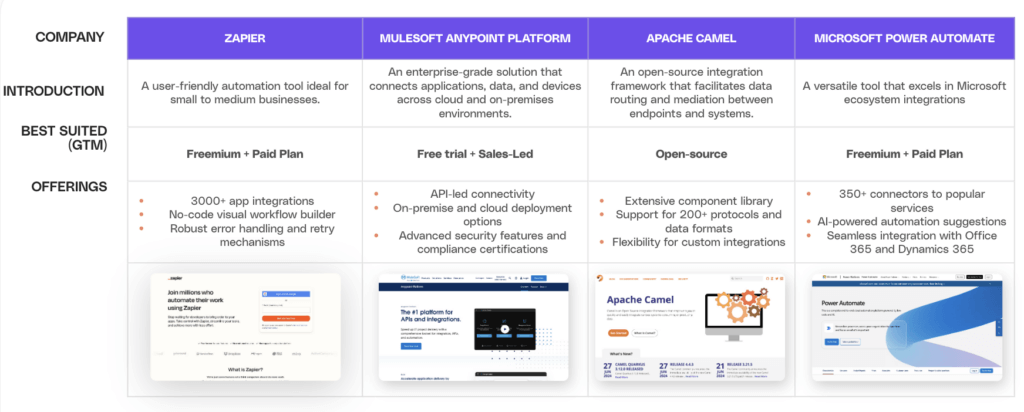
These tools offer intuitive interfaces, robust security, and extensive connectivity options, making integration loop implementation more efficient and manageable.
Best practices
To ensure successful implementation of integration loops, follow these best practices:
- Start Small: Begin with a pilot project or proof of concept to validate the effectiveness of the integration loop before scaling up.
- Secure Data: Implement appropriate security measures to protect sensitive data during the integration process.
- Monitor Performance: Continuously monitor the performance of the integration loop, identifying bottlenecks or areas for improvement.
- Keep Documentation: Maintain clear and updated documentation of the integration loop design, configuration, and troubleshooting guidelines.
- Ensure Scalability: Design the integration loop to handle increasing data volumes and changing business needs over time.

Troubleshooting integration loops
Even with meticulous planning, integration loops can encounter challenges that impact customer experience and product performance. Common issues include inconsistencies in data due to inaccuracies in how information is mapped between systems. Resolving this involves ensuring seamless data integration to enhance the reliability and accuracy of customer-facing services.
Performance degradation may occur from inefficient data transformation processes and excessive data transfers, affecting the speed and responsiveness of products. Optimizing these processes improves efficiency, ensuring smoother customer interactions and faster service delivery.
Inadequate error handling can lead to unnoticed issues that affect system stability and reliability. By implementing robust error detection and resolution mechanisms, companies can maintain data integrity, ensuring a consistent and reliable experience for customers.
Additionally, connectivity issues stemming from network disruptions can disrupt data flow and affect service availability. Proactive monitoring and rapid response to such issues are crucial to maintaining seamless connectivity and ensuring uninterrupted access to services, thereby enhancing overall customer satisfaction and loyalty.
Optimizing integration loops
Improving integration loops can lead to improved performance, increased efficiency, and enhanced scalability. Here are some techniques for achieving optimal integration loop performance:
Techniques for improving integration loop performance
Enhanced integration loop performance supports company profitability and enhances user experience by ensuring reliable data processing, accurate information across platforms, and seamless service delivery. Scalable infrastructure, proactive monitoring, and robust error handling are essential techniques for achieving these benefits while maintaining operational efficiency and customer satisfaction.
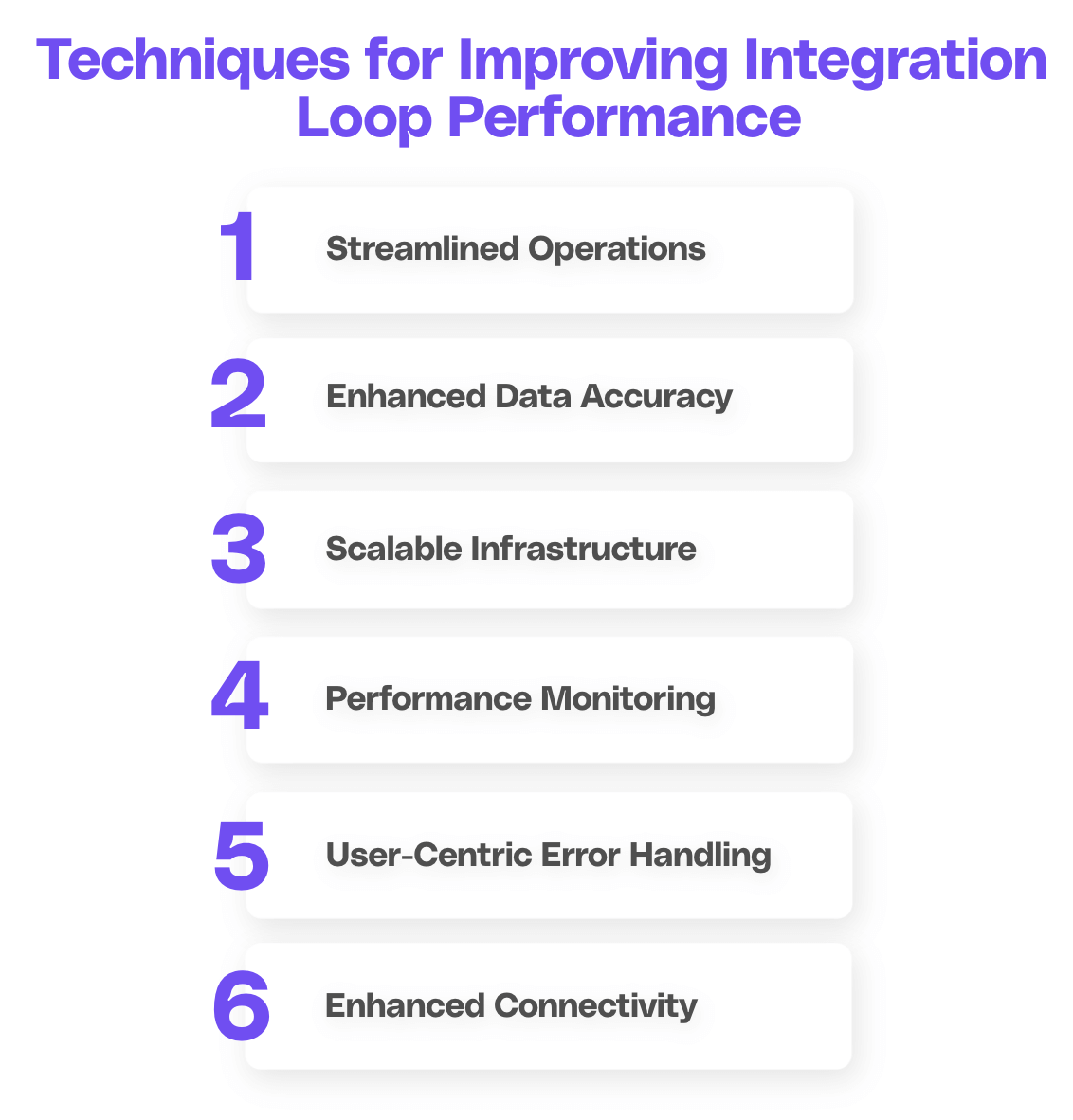
Measuring the efficiency
Measuring the efficiency of an integration loop involves assessing key performance indicators (KPIs) such as data processing speed, error rates, and system uptime to gauge how effectively it supports user interactions and service delivery. By tracking these metrics, businesses can ensure seamless and reliable data flow across platforms, enhancing user experience by minimizing disruptions and optimizing response times. Regular monitoring and analysis enable proactive adjustments to improve usability, streamline workflows, and meet customer expectations for efficiency and reliability.
Future trends
Integration loops are continually evolving to meet the demands of a rapidly advancing technological landscape. Here are some emerging trends to watch out for:
- AI and Machine Learning: These technologies are set to revolutionize integration loops by enabling intelligent data mapping and automated optimization, improving efficiency and reducing manual effort.
- IoT Integration: As the number of connected devices grows, integration loops must handle massive volumes of real-time data from IoT sensors and devices, necessitating scalable and efficient data processing capabilities.
- Blockchain Technology: Blockchain offers secure and transparent data exchange, enhancing data integrity and trust in integration processes across disparate systems.
- Serverless Computing: Leveraging serverless architectures enables scalable, event-driven integration processes, reducing operational overhead and improving agility in handling integration tasks.
- 5G and Edge Computing: With ultra-low latency and high bandwidth capabilities, 5G and edge computing facilitate real-time integrations, enabling faster decision-making and responsiveness in distributed environments.
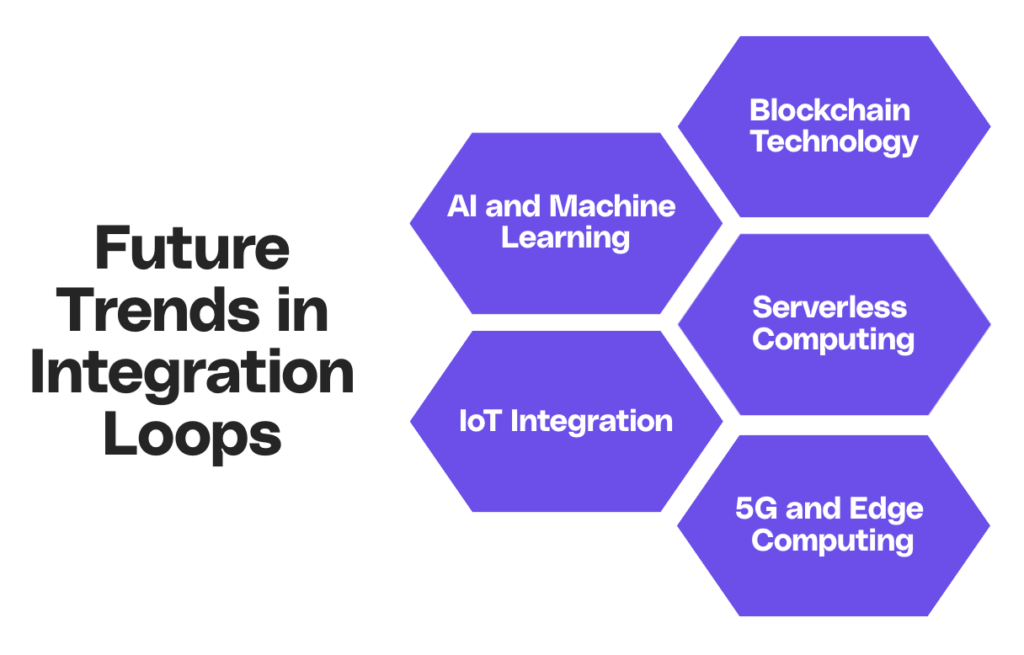
Prediction and preparation for the future
Looking forward, integration loops are evolving with advanced technologies, emphasizing user value, customer experience, and product innovation. Key trends include increased automation, hybrid and multi-cloud integrations for flexibility, and API-first and microservices architectures for scalability.
Security, compliance, and robust data governance are critical, alongside the democratization of integration through low-code/no-code platforms. Real-time and event-driven integration patterns will be standard, meeting dynamic business needs, while integration with emerging technologies like AR, quantum computing, and robotics opens new possibilities.
To prepare, organizations should focus on continuous upskilling, flexible architectures, and strong data governance. Embracing open standards promotes interoperability and fosters innovation, while rigorous security measures ensure data protection and stakeholder trust.
Conclusion
Integration loops are an essential component of modern business systems, enabling efficient data integration and synchronized operations. By understanding the basics, types, design considerations, implementation best practices, troubleshooting techniques, optimization strategies, and future trends of integration loops, you are well-equipped to leverage their benefits and drive your organization's success in an increasingly interconnected world.
Empower your integration with Cello
As you harness integration loops to streamline your processes, consider amplifying your growth with equal efficiency. Cello transforms your users into a powerful growth channel by integrating seamlessly with your SaaS product, launching a peer-to-peer referral program in hours. Experience user-led growth with minimal development time, quick payback, and high conversion rates. Our seamless integration and automated rewards revolutionize your referral strategy, making product sharing frictionless and rewarding. Ready to see how Cello can boost your business with user referrals, as it did for tl;dv? Book a demo to witness the potential of effortless integration and viral growth firsthand.
Resources
Related Articles

Complete Guide to Sales Growth Loops
Discover the power of sales growth loops and how they drive business success.
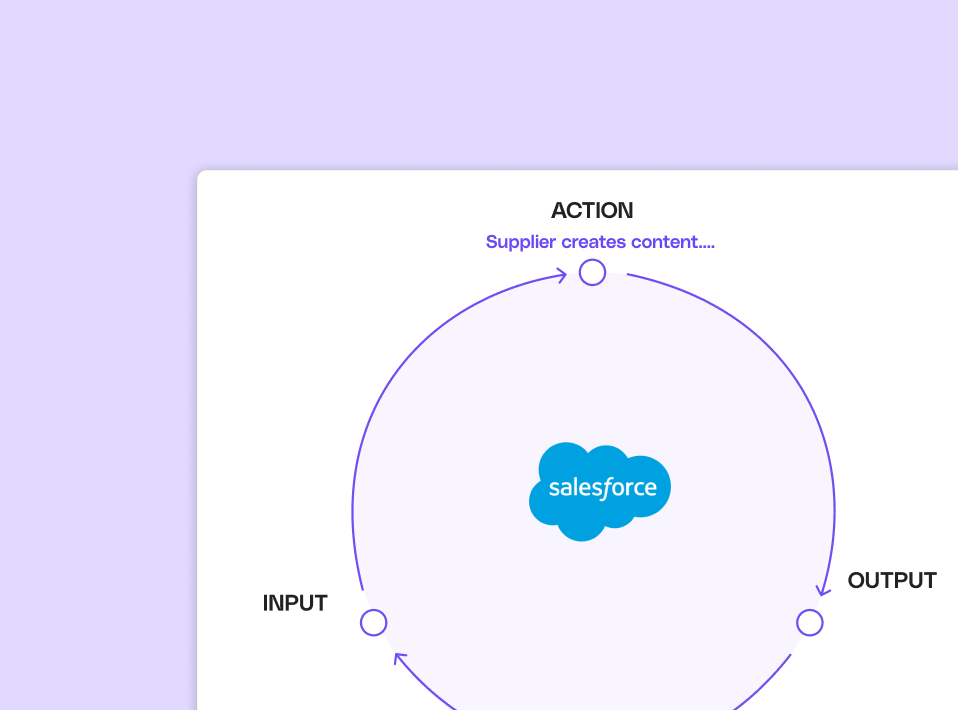
Complete Guide to Supplier-Generated Content Loops
Discover how supplier-generated content loops can revolutionize your marketing strategy and ...

Complete Guide to your Affiliate Program for B2B SaaS
Learn how to get started with affiliate referral programs for B2B SaaS. Understand if affiliate ...
